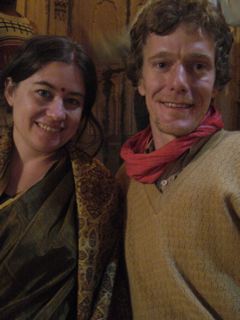Blogger is, annoyingly, making it difficult for me to match up text and photos -- I will try to remedy this, but for now, here's the next batch ----
Bunches and bunches of pictures! First, a termite mound: a very interesting thing. These dot the hills all around Haridwar, and all over India. They can be 20-30 years old, and because cobras like to live in them, they are treated as sacred (the cobra is a symbol of Shiva) -- villagers who have one will pour ghee or milk on it, and strew flowers on it... Aaron was fascinated by them and has many drawings of them -- perhaps I will requisition his sketchbook and scan one in.


This image is from our last evening in Haridwar -- goodbye to all the banana-leaf flower boats on the Ganges. The morning after this, we took an early (pre-dawn) train South toward Vrindavan, where we had a place reserved at the ancient ashram Gambhira (Jai Singh Ghera), the ancestral home of the Goswami family.
www.hinduonnet.com/thehindu/thscrip/print.pl?file=2003121901561000.htm&date=2003/12/19/&prd=fr&Srivatsa Goswami, the next Maharishi of the Radha Raman temple there, runs the ashram as a kind of scholars' retreat. We were lucky enough to be there for a Seva (festival) which ran for a week, and to experience daily services in the temple: singing, dancing, and all kinds of joyful expression of love for Krishna and between Krishna and Radha. Vrindavan is the place where that love story takes place, and keeps taking place... the Goswami family traces their lineage back 16 generations to a disciple of Sri Chaitanya, a 15th-century incarnation of Krishna.
http://en.wikipedia.org/wiki/Chaitanya_MahaprabhuThe whole place is very dreamlike, since they say the Radha-Krishna leela (story) is still always taking place around you there, even if you can't see it. You can definitely hear it: it is a town of bells around the clock, and singing, and dressing-up! Krishna is all around you -- as a baby dipping his hand in a stolen butter-pot, a cowherd stealing the milkmaids' clothes while they are bathing, the lover of smitten beautiful Radha. The Radha Raman temple -- the Goswami heritage -- is home to a figure of Krishna which is said to have sprung of its own accord from a Salagram Sila (a smooth black stone from the Kali-Gandaki river in Nepal -- Vedic scriptures say that Srimati Tulasi Devi cursed Krishna to become a stone, and since then he has manifested himself as the Salagram Sila).
Here is more about the temple:
http://www.salagram.net/sstp-RadhaRamanVrindavan.htmlHere are some pictures from our stay in Vrindavan, which is particularly plagued by monkeys. We got no end of joy from watching them -- they are very funny and very very smart. Vrindavan's residents don't seem to find them so funny, though -- they steal everything that isn't tied down, and are especially fond of stealing the glasses off of people's faces, and holding them as collatoral for bananas. In this picture, Aaron has a big stick, which he periodically had to bang on the floor to keep the monkeys from stealing his pencils, etc...




Here is a monkey running across a rooftop with somebody's glasses. In this particular instance, the de-spectacled man offered the monkey a hot pepper instead of the customary banana as ransom for the glasses. The monkey was not amused, and bit the glasses in half before tossing them back down to their owner...



Here we are with our wonderful friend Robyn Beeche, who lives at Jai Singh Ghera and runs all kinds of scholarly programs, and does all the photography there. She moved from London in the 80's, where she had been taking photographs of everybody from Divine to Boy George to Adam Ant, to Vrindavan, where she takes divine photographs of the Radha Raman temple and its events, and travels frequently, photographing craftsmen and women and festivals all over the country.






Robyn lent me an amazing saree for our trip to to Agra, where we visited the Taj Mahal and the Agra Fort. Agra is a day-trip from Vrindavan (see the somewhat blurry photo of an extremely overloaded vehicle we saw on the way there!), but pretty much a horrible tourist trap. You have to dodge all kinds of touts (scam artists) to get to the attractions, but... in fact... the Taj is worth it -- we were particularly impressed by the quality of sound inside -- the decay is very very slow in the dim marble interior, so each tone seemed to go on and on forever. Perhaps this had something to do with the fact that it is an octagon, so the harmonics are extremely vibrant? (Or perhaps that's a bit of Modern Jackass [see TAL Episode 293] -- any sound experts out there?) ANYway, it is such an amazing meditation on time and loss and monumentality and love.

You have to wear little booties at the Taj so you won't scuff the marble...







The Agra Fort is also amazing. The black stone slab is the throne of Jahangir -- see the inscribed marble stone to read about his Justice Dept.

Finally -- some pictures of an insane Italianate mansion in the heart of Vrindavan, built by someone with a romantic imagination and lots and lots of money. We had the good fortune to be joined in Vrindavan by our friend Fred Smith, a Sanskrit scholar who knows Vrindavan like the back of his hand, and took us around to meet the perfume-walla and see the Salagram temple and so forth and so forth...




















































